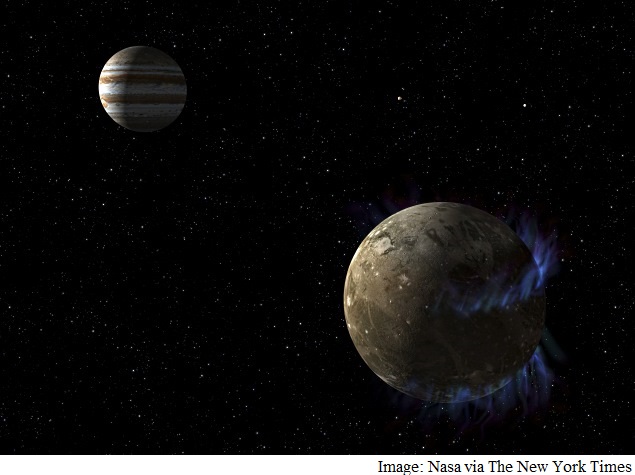Suddenly, It Seems, Water Is Everywhere in Solar System

This week in the journal Nature, an international team of scientists reported evidence for hydrothermal vents on the Saturnian moon Enceladus, with temperatures of its rocky core surpassing 194 degrees Fahrenheit (90 degrees Celsius) in spots. The discovery, if confirmed, would make Enceladus the only place other than Earth where such chemical reactions between rock and heated water are known to be occurring today - and for many scientists, it would make Enceladus a most promising place to look for life.
"The most surprising part is the high temperature," said Hsiang-Wen Hsu, a scientist at the University of Colorado's Laboratory for Atmospheric and Space Physics and lead author of the paper. "But that's the number we could derive."
Meanwhile, in a paper published Thursday in The Journal of Geophysical Research: Space Physics, another team reported signs of another under-ice ocean, on Ganymede, the largest of Jupiter's moons. Scientists are already convinced that there is a large ocean, also covered by ice, on another Jovian moon, Europa. Nasa's Galileo spacecraft had also found hints of hidden water on Ganymede and on another of Jupiter's moons, Callisto.
The new research, using the Hubble Space Telescope, fits with the earlier hints. "This is now stronger evidence for an ocean," said Joachim Saur, a professor of geophysics at the University of Cologne in Germany and the lead author of the Ganymede paper.
"Surprising is the understatement," Christopher P. McKay, a planetary scientist at the Nasa Ames Research Center in Mountain View, California, said of the multitude of watery moons.
"After spending so many years going after Mars, which is so dry and so bereft of organics and so just plain dead, it's wonderful to go to the outer solar system and find water, water everywhere," said McKay, who studies the possibility of life on alien worlds. He was not involved in either of the papers.
For the Enceladus findings, Hsu and his colleagues based their conclusions on minuscule dust particles that Nasa's Cassini spacecraft encountered as it approached Saturn and after it entered orbit. Instruments on Cassini determined that the particles, less than a millionth of an inch in diameter, were high in silicon but had little or no metals like sodium or magnesium. Hsu said the dust was probably silica, a molecule of one silicon and two oxygen atoms, the building block of the mineral quartz.
The researchers were also able to trace the dust to Saturn's E Ring, and the material in the E Ring originates from Enceladus, from plumes that emanate near the moon's south pole. "That's the circumstantial part of the work," Hsu acknowledged.
They performed laboratory experiments to see which conditions could produce the silica particles. The result was alkaline water, with a pH of 8.5 to 10.5, heated to at least 194 degrees. The results fit in with findings last year by other scientists who suggested that Enceladus concealed not just pockets of water but a sea at least as large as Lake Superior.
The mystery is how the interior of Enceladus, just 313 miles wide, grows that hot. A moon that small probably does not have enough radioactive elements at its core to provide continued warmth. A chemical reaction between water and rock called serpentinization could also provide some heat, but the primary mechanism is probably the tidal forces that Saturn exerts on Enceladus.
"The amount of energy being dissipated currently, as well as the location of heating, is not well understood," said Terry A. Hurford, a scientist at Nasa's Goddard Space Flight Center in Maryland. "So it is possible that heating can bring water to those temperatures locally."
The earlier evidence for an ocean on Ganymede came from magnetic measurements during flybys by the Galileo probe, which suggested a conductive layer below the surface. Ice is not a good conductor. Saltwater is. But the readings could also be explained by oddities in Ganymede's magnetic field.
In the new research, the Hubble telescope scrutinized Ganymede for seven hours. It could not see below the surface, but it observed the shimmering lights of Ganymede's auroras. As Jupiter rotates, once every 10 hours, its changing magnetic field causes the auroras to sway. If Ganymede were frozen, computer simulations showed, its aurora would sway by 6 degrees. But the salts of an under-ice ocean would generate a counteracting magnetic field, and the auroras would sway by only 2 degrees.
The auroras swayed 2 degrees. "It was exactly like all our computer modeling and all our theory predicted," Saur said. "It was right on."
The scientists are now applying the approach to Io, a fiery world that certainly does not have an ocean of water. But it might have an underground ocean of magma that would similarly dampen the swaying of auroras. The technique could one day be used to explore planets around distant stars and see if they, too, might have oceans.
As a place for life, Ganymede is less promising, because the ocean looks to be sandwiched between layers of ice and not in contact with rock. By contrast, Enceladus appears to possess all of the necessary ingredients - heat, liquid water and organic molecules - and a future probe could analyze the water by simply flying through the plumes.
"My mantra now is follow the plume," McKay said.
© 2015 New York Times News Service
For the latest tech news and reviews, follow Gadgets 360 on X, Facebook, WhatsApp, Threads and Google News. For the latest videos on gadgets and tech, subscribe to our YouTube channel. If you want to know everything about top influencers, follow our in-house Who'sThat360 on Instagram and YouTube.
